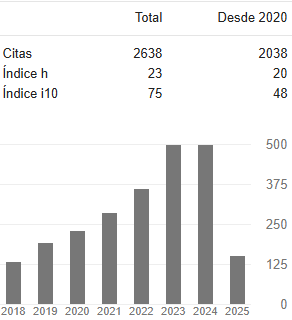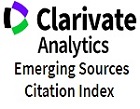Una revisión del estado del arte de la medida de la nanodureza usando el Microscopio de Fuerza Atómica
DOI:
https://doi.org/10.31908/19098367.556Palabras clave:
nanodureza, microscopio de fuerza atómica, modelo de Oliver Pharr, espectroscopia de fuerzasResumen
En la nanociencia y en la nanotecnología, una de las herramientas más poderosas es el microscopio de fuerza atómica (AFM siglas en inglés). Instrumento que sirve para caracterizar los materiales a nivel superficial. Dentro de esas características está evaluar la dureza a escala manometría (nanodureza), utilizando el método de nanoindentación en el modo de espectroscopia. En materiales como las películas delgadas en los que sus espesores son del orden de decenas de nanómetros de espesor, el equipo adecuado para medir la dureza es el AFM. En este artículo se pretende realizar una primera aproximación a algunos modelos usados para evaluar la dureza usando el AFM a partir del modelo elástico.
Descargas
Referencias
M. F. Doerner and W. D. Nix, “A method for interpreting the data from depth-sensing indentation instruments,” Journal of Materials Research, vol. 1, pp. 601-609, 1986.
W. C. Oliver and G. M. Pharr, “An improved technique for determining hardness and elastic modulus using load and displacement sensing indentation experiments,” Journal of Materials Research, vol. 7, pp. 1564-1583, 1992.
W. C. Oliver and G. M. Pharr, “Measurement of hardness and elastic modulus by instrumented indentation: Advances in understanding and refinements to methodology,” Journal of Materials Research, vol. 19, pp. 3-20, 2004.
G. M. Pharr, “Measurement of mechanical properties by ultra-low load indentation,” Materials Science and Engineering: A, vol. 253, pp. 151-159, 9/30/ 1998.
G. M. Pharr, W. C. Oliver, and F. R. Brotzen, “On the generality of the relationship among contact stiffness, contact area, and elastic modulus during indentation,” Journal of Materials Research, vol. 7, pp. 613-617, 1992.
I. Jauberteau, M. Nadal, and J. L. Jauberteau, “Atomic force microscopy investigations on nanoindentation impressions of some metals: effect of piling-up on hardness measurements,” Journal of Materials Science, vol. 43, pp. 5956-5961, 2008/09/01 2008.
J. Boussinesq, “Application des Potentials `a l’´equilibre et du Mouvememt des Solider ´elastiques,” Gauthier-Villars, Paris, vol. 45, p. 108, 1885.
H. Hertz, “Translated and reprinted in English in “Hertz’s Miscellaneous Papers”,” J. Reine Angew. Math, vol. 92, p. 156, 1881.
H. Hertz, “Verhandlungen des Vereins zur Bef¨orderung des Gewerbe Fleisses,” Translated and reprinted in English in “Hertz’s Miscellaneous Papers” (Macmillan & Co, London, 1896) Ch. 6., vol. 61, p. 410, 1882.
I. N. Sneddon, “The relation between load and penetration in the axisymmetric boussinesq problem for a punch of arbitrary profile,” International Journal of Engineering Science, vol. 3, pp. 47-57, 5// 1965.
I. 14577-1, “Metallic Materials-Instrumented Indentation Test for Hardness and Materials Parameters “ in Part 1: Test Method, ed, 2002.
I. 14577-2, “Metallic Materials-Instrumented Indentation Test for Hardness and Materials Parameters,” in Part 2: Verification and Calibration of Testing Machines, ed, 2002.
I. 14577-3, “Metallic Materials-Instrumented Indentation Test for Hardness and Materials Parameters,” in Part 3: Calibration of Reference Blocks, ed, 2002.
L.-P. CHAO, J.-S. HSU, and Y.-D. LAU, “Measurement Of Nanomechanical Properties Of Thin Films By Integrating Nanoindentation System And Atomic Force Microscope,” International Journal of Nanoscience, vol. 06, pp. 57-64, 2007.
M. Finke, J. A. Hughes, D. M. Parker, and K. D. Jandt, “Mechanical properties of in situ demineralised human enamel measured by AFM nanoindentation,” Surface Science, vol. 491, pp. 456-467, 10/1/ 2001.
T. Kocourek, M. Růžek, M. Landa, M. Jelínek, J. Mikšovský, and J. Kopeček, “Evaluation of elastic properties of DLC layers using resonant ultrasound spectroscopy and AFM nanoindentation,” Surface and Coatings Technology, vol. 205, Supplement 2, pp. S67-S70, 7/25/ 2011.
P. Milovanovic, J. Potocnik, D. Djonic, S. Nikolic, V. Zivkovic, M. Djuric, et al., “Age-related deterioration in trabecular bone mechanical properties at material level: Nanoindentation study of the femoral neck in women by using AFM,” Experimental Gerontology, vol. 47, pp. 154-159, 2// 2012.
E. A-Hassan, W. F. Heinz, M. D. Antonik, N. P. D’Costa, S. Nageswaran, C.-A. Schoenenberger, et al., “Relative Microelastic Mapping of Living Cells by Atomic Force Microscopy,” Biophysical Journal, vol. 74, pp. 1564-1578, 1998.
L. Calabri, N. Pugno, C. Menozzi, and S. Valeri, “AFM nanoindentation: tip shape and tip radius of curvature effect on the hardness measurement,” Journal of Physics: Condensed Matter, vol. 20, p. 474208, 2008.
B. Du, J. Zhang, Q. Zhang, D. Yang, T. He, and O. K. C. Tsui, “Nanostructure and Mechanical Measurement of Highly Oriented Lamellae of Melt-Drawn HDPE by Scanning Probe Microscopy,” Macromolecules, vol. 33, pp. 7521-7528, 2000/10/01 2000.
M. Mareanukroh, R. K. Eby, R. J. Scavuzzo, G. R. Hamed, and J. Preuschen, “Use of Atomic Force Microscope as a Nanoindenter to Characterize Elastomers,” Rubber Chemistry and Technology, vol. 73, pp. 912-925, 2000.
Z. Shan and S. K. Sitaraman, “Elastic–plastic characterization of thin films using nanoindentation technique,” Thin Solid Films, vol. 437, pp. 176-181, 8/1/ 2003.
E. Tomasetti, R. Legras, and B. Nysten, “Quantitative approach towards the measurement of polypropylene/(ethylenepropylene) copolymer blends surface elastic properties by AFM,” Nanotechnology, vol. 9, p. 305, 1998.
F. Sansoz and T. Gang, “A force-matching method for quantitative hardness measurements by atomic force microscopy with diamondtipped sapphire cantilevers,” Ultramicroscopy, vol. 111, pp. 11-19, 12// 2010.
C. A. Clifford and M. P. Seah, “Quantification issues in the identification of nanoscale regions of homopolymers using modulus measurement via AFM nanoindentation,” Applied Surface Science, vol. 252, pp. 1915-1933, 12/15/ 2005.
J. Lee, C. Y. Kim, M. Joo, and K. Park, “Uncertainty compensation methods for quantitative hardness measurement of materials using atomic force microscope nanoindentation technique,” Thin Solid Films, vol. 546, pp. 448-452, 11/1/ 2013.
B. Bhushan and V. N. Koinkar, “Nanoindentation hardness measurements using atomic force microscopy,” Applied Physics Letters, vol. 64, pp. 1653-1655, 1994.
J. R. Withers and D. E. Aston, “Nanomechanical measurements with AFM in the elastic limit,” Advances in Colloid and Interface Science, vol. 120, pp. 57-67, 6/30/ 2006.
D. Beegan, S. Chowdhury, and M. T. Laugier, “Work of indentation methods for determining copper film hardness,” Surface and Coatings Technology, vol. 192, pp. 57-63, 3/1/ 2005.
K. Miyake, S. Fujisawa, A. Korenaga, T. Ishida, and S. Sasaki, “The Effect of Pile-Up and Contact Area on Hardness Test by Nanoindentation,” Japanese Journal of Applied Physics, vol. 43, p. 4602, 2004.
W. J. Poole, M. F. Ashby, and N. A. Fleck, “Micro-hardness of annealed and work-hardened copper polycrystals,” Scripta Materialia, vol. 34, pp. 559-564, 2/15/ 1996.
R. Saha, Z. Xue, Y. Huang, and W. D. Nix, “Indentation of a soft metal film on a hard substrate: strain gradient hardening effects,” Journal of the Mechanics and Physics of Solids, vol. 49, pp. 1997- 2014, 9// 2001.
D. Tabor, A Simple Theory of Static and Dynamic Hardness vol. 192, 1948.
N. A. Stilwell and D. Tabor, “Elastic Recovery of Conical Indentations,” Proceedings of the Physical Society, vol. 78, p. 169, 1961.
K. L. Johnson, Contact Mechanics. United Kingdom: Cambridge University Press, 1985.
N. J. M. Carvalho and J. T. M. DeHosson, “Microstructure investigation of magnetron sputtered WC/C coatings deposited on steel substrates,” Thin Solid Films, vol. 388, pp. 150-159, 6/1/ 2001.
B. Cappella and G. Dietler, “Force-distance curves by atomic force microscopy,” Surface Science Reports, vol. 34, pp. 1-104, // 1999.
H.-J. Butt, B. Cappella, and M. Kappl, “Force measurements with the atomic force microscope: Technique, interpretation and applications,” Surface Science Reports, vol. 59, pp. 1-152, 10// 2005.
S. A. Chizhik, Z. Huang, V. V. Gorbunov, N. K. Myshkin, and V. V. Tsukruk, “Micromechanical Properties of Elastic Polymeric Materials As Probed by Scanning Force Microscopy,” Langmuir, vol. 14, pp. 2606-2609, 1998/05/01 1998.
V. V. Tsukruk, Z. Huang, S. A. Chizhik, and V. V. Gorbunov, “Probing of Micromechanical Properties of Compliant Polymeric Materials,” Journal of Materials Science, vol. 33, pp. 4905-4909, 1998/10/01 1998.
M. Griepentrog, G. Krämer, and B. Cappella, “Comparison of nanoindentation and AFM methods for the determination of mechanical properties of polymers,” Polymer Testing, vol. 32, pp. 455-460, 5// 2013.
L. Calabri, N. Pugno, A. Rota, D. Marchetto, and S. Valeri, “Nanoindentation shape effect: experiments, simulations and modelling,” Journal of Physics: Condensed Matter, vol. 19, p. 395002, 2007.
N. M. Pugno, “A general shape/size-effect law for nanoindentation,” Acta Materialia, vol. 55, pp. 1947-1953, 4// 2007.
R. J. Emerson Iv and T. A. Camesano, “On the importance of precise calibration techniques for an atomic force microscope,” Ultramicroscopy, vol. 106, pp. 413-422, 3// 2006.
S. Garcia-Manyes, A. G. Güell, P. Gorostiza, and F. Sanz, “Nanomechanics of silicon surfaces with atomic force microscopy: An insight to the first stages of plastic deformation,” The Journal of Chemical Physics, vol. 123, p. 114711, 2005.
C. A. Clifford and M. P. Seah, “The determination of atomic force microscope cantilever spring constants via dimensional methods for nanomechanical analysis,” Nanotechnology, vol. 16, p. 1666, 2005.
J. M. Neumeister and W. A. Ducker, “Lateral, normal, and longitudinal spring constants of atomic force microscopy cantilevers,” Review of Scientific Instruments, vol. 65, pp. 2527-2531, 1994.
E. C. C. M. Silva and K. J. V. Vliet, “Robust approach to maximize the range and accuracy of force application in atomic force microscopes with nonlinear position-sensitive detectors,” Nanotechnology, vol. 17, p. 5525, 2006.
L. Y. Beaulieu, M. Godin, O. Laroche, V. Tabard-Cossa, and P. Grütter, “A complete analysis of the laser beam deflection systems used in cantilever-based systems,” Ultramicroscopy, vol. 107, pp. 422-430, 4// 2007.
T. Bao, P. W. Morrison, and W. Woyczynski, “AFM Nanoindentation as a Method to Determine Microhardness of Hard Thin Films,” MRS Entre Ciencia e Ingeniería 74 Online Proceedings Library, vol. 517, pp. null-null, 1998.
R. C. S. Graça, R. Vilar, “Using Atomic Force Microscopy to Retrieve Nanomechanical Surface Properties of Materials,” Materials Science Forum, vol. 514-516, pp. 1598-1602, 2006.
M. Lucas, K. Gall, and E. Riedo, “Tip size effects on atomic force microscopy nanoindentation of a gold single crystal,” Journal of Applied Physics, vol. 104, p. 113515, 2008.
Y. D. Yan, T. Sun, and S. Dong, “Study on effects of tip geometry on AFM nanoscratching tests,” Wear, vol. 262, pp. 477-483, 2/4/ 2007.
Descargas
Publicado
Número
Sección
Licencia
Derechos de autor 2019 Entre Ciencia e Ingeniería

Esta obra está bajo una licencia internacional Creative Commons Atribución-NoComercial 4.0.



















